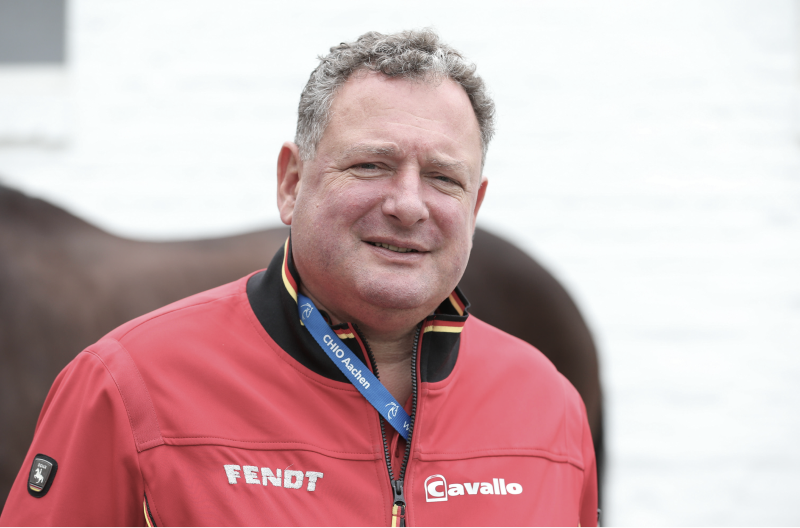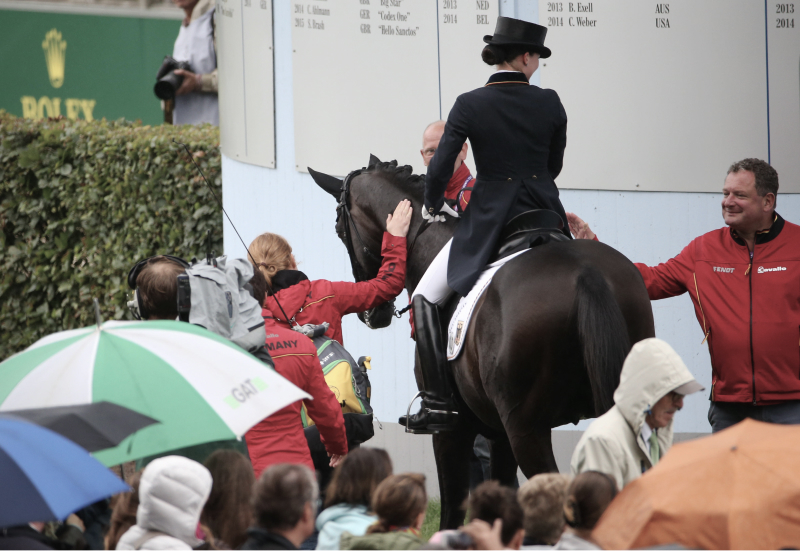
22 September 2023
If you have ever attended one of the major equestrian events in the last decade, chances are that you have caught a glimpse of Marc Koene, previously team veterinarian for the German Olympic Driving Team and currently holding the same position for the German Dressage Team. He has served these teams at several Olympic Games, World Equestrian Games and German and European Championships. We managed to get a short talk with him at the 2023 German Dressage Championships in Balve.

Apart from being a team vet for Germany, Marc Koene co-runs the biggest equine clinic in the country, the Veterinary Clinic Lüsche, where he works on lame horses, surgery, ophthalmology, sporthorse support and pre-purchase examinations. Additionally, he is active in research and application of new technologies, including 3D printing, feed supplements and laser treatment.
The Veterinary Clinic Lüsche is currently one of the largest equine clinics in Europe with approximately 140 employees and apart from Germany is also established in Shanghai, Sweden and Samorin. Marc Koene and colleagues have developed the clinic into a global leader of gait analysis.
“One reason for our success is our openness to new technology. I like to test new things which are practical and can add value to our clinic – using an AI-powered objective gait analysis app like Sleip is one example. It’s really added value for us. Sometimes when you do your assessment, you will fix on something – and sometimes the data received from the app will point you in another, more correct direction. That’s what I like.”
Before Sleip introduced the sharing feature that allows vets to share access to record horses remotely, Marc had to drive to see every team rider and their horses. Today, he invites the riders to collect data at home by trotting their horses up and recording with their iPhones through the Sleip app. The gait metrics and analysis video are automatically sent to Marc through Sleip.
“It saves me from long journeys to check horses which turn out to be perfectly sound. We can, and I think this is the main advantage, do longitudinal monitoring and have early detection of asymmetries compared to baseline. This means that we have the fingerprint of the baseline and then we can see early developments. I can also share our documentation and videos with other professionals in the network around the horse, like the farrier, physio and chiropractor, which is very good.”
Marc Koene says that young riders are in general more open to taking advantage of this new technology than some older riders, who claim that they can feel if something is wrong with the horse “with their butts”. The data received from the app can sometimes worry the rider, as it reveals asymmetries in the horse’s movements.
“If you look at competition horses, none of them are perfectly symmetrical – and still they are placed first, second or third. There are a lot of discussions right now about what symmetry is normal, the definition of “fit to compete”, and what asymmetry is too much. Our work is not always black or white, but objective gait analysis is a good tool in assisting us in our work – although it cannot replace the knowledge, skills and experience, which we need to evaluate the data in order to see the bigger picture,” Marc Koene says.
“We need to establish what asymmetry is normal. We know this from human sports, as a marathon runner can be very asymmetrical – and still be at the top of the sport. When following horses over time, I can evaluate asymmetries and conclude whether they are caused by pain and if so, treat it.”
When asked about what Marc Koene sees as the greatest reward of his profession, he replies “a happy, sound horse – and a happy owner”.
“This is one of the reasons why I still like to do teamwork; you see horses doing the sport. It also gives you a better understanding of the whole picture – and why things sometimes go wrong in training or competition.
As a team vet, when you travel with the horses, you get to know them really well. You spend night and day with them. It’s a lot about looking after the well-being of the horse and being good with your hands, giving the horses massage, physiotherapy and acupuncture. You must build trust and make horses respect you. For me it’s very rewarding when horses recognise me and seem to enjoy when I come. Some say that they even smile when I enter the stables.”
Marc Koene was born in the Netherlands but raised in Germany, where his interest in animals began at a very young age.
"According to my parents, I’ve wanted to become a veterinarian since the age of 4. After finishing veterinary school in Hannover in Germany, I spent a few years working at the Kentucky Downs in the US, which is a big horse industry where everything revolves around horses. I loved it.”
After returning to Europe in the late 1980’s, Marc Koene specialised in reproduction and became a pioneer in embryo transfer programs with assignments for Paul Schockemöhle.
“I eventually turned my focus to equine orthopaedics, an interesting and extremely fast developing area in which exciting new technology, like AI, creates new opportunities. A reason why I like the Sleip app, for instance, is that it brings objectivity into the very subjective business of orthopedic surgery. It’s very good both for surgeons at the clinic and students to see lameness visualised and to understand the compensation mechanism."
Some say it’s an art to do a lameness assessment – now we can add the science of objectivity to the art.
“At our clinic, we have been using objective gait analysis for quite some time. And when we introduced Sleip, it only took three weeks before everyone was doing it because it’s practical, easy to use and to interpret the data. For me it’s a no-brainer, it’s one of those game-changing products. Every ten years you’ll find a product which really changes the market. And I think Sleip is one of these. It helps us to become better vets.”